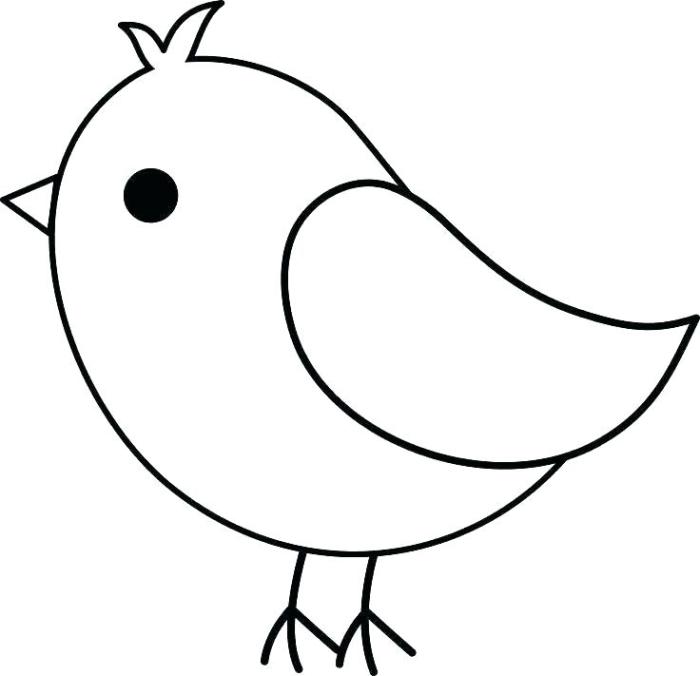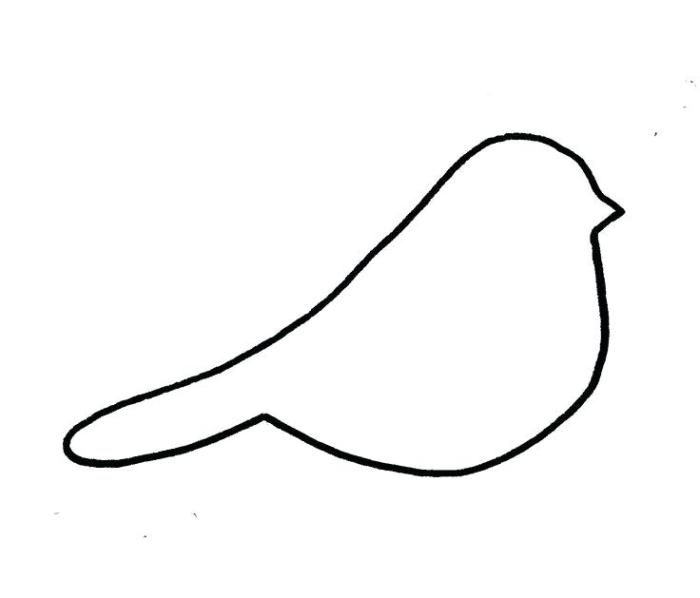Depicting Bird Flight in a Simple Way

Bird flying outline drawing easy – Drawing birds in flight might seem daunting, but with a grasp of basic aerodynamics and some simple line techniques, you can create dynamic and believable images. This section will break down the process, focusing on simplicity and capturing the essence of movement.Bird flight is all about manipulating air. Think of a bird’s wing as a cleverly designed airfoil – a shape that generates lift when air flows over it.
The curved upper surface of the wing causes air to travel faster over the top, creating lower pressure above the wing compared to the higher pressure below. This pressure difference generates the upward force, or lift, that keeps the bird aloft. The angle of the wing (the angle of attack) also plays a crucial role; a steeper angle generates more lift, but also more drag.
A bird controls its flight by adjusting the angle of its wings, its body position, and the speed of its wingbeats.
Wing Movement and Body Position in Bird Flight
The way a bird moves its wings dramatically impacts its flight style. Rapid, powerful wingbeats create thrust for flapping flight, while a more relaxed wing position is ideal for gliding and soaring. A bird’s body position also plays a significant role. A tilted body can help generate additional lift during a turn, while a streamlined, horizontal position minimizes drag during fast, level flight.
For example, a swift in pursuit of prey will maintain a low, horizontal body position to reduce air resistance, while a hawk circling overhead will subtly adjust its body angle to maintain altitude with minimal effort.
Creating a Sense of Movement and Speed, Bird flying outline drawing easy
Line variation is your secret weapon for conveying movement. Thicker lines can emphasize powerful wingbeats or the force of a bird diving, while thinner lines can suggest the grace of a soaring bird or the speed of a swift flight. Curved lines are crucial for showing the path of the bird; a gently curved line indicates a smooth, gliding flight, whereas a series of sharp, angular lines might depict a bird making sudden turns or evasive maneuvers.
Consider varying line weight to indicate speed and emphasis; heavier lines where the bird is most powerful and lighter lines in areas of transition or less forceful movement.
Three Different Flight Styles
Here are three depictions of birds in flight, each illustrating a distinct style: Soaring: Imagine a large bird of prey, like a condor, effortlessly circling on thermal updrafts. The drawing would feature a relatively flat wing shape, with thin, gently curved lines depicting a smooth, almost effortless flight path. The body would be slightly angled, and the tail feathers might be slightly spread, indicating stability.
The lines would be thin and flowing, suggesting a sense of tranquility and ease. Flapping: Picture a robin, rapidly beating its wings to navigate a cluttered environment. The drawing would show clearly defined wings with thicker lines to illustrate the powerful wingbeats. The wings would be depicted in various positions throughout the stroke, perhaps slightly blurred or slightly separated lines at the tips to suggest motion blur.
The body would be more compact and less streamlined than the soaring bird, suggesting the exertion of effort. The lines would be more dynamic and less fluid. Gliding: Visualize an albatross, using wind currents to glide for extended periods. The drawing would show long, slender wings with slightly curved lines, implying a smooth, effortless glide. The body would be streamlined and horizontal, suggesting minimal air resistance.
The lines would be thin but strong, suggesting the steady, controlled movement of gliding flight. The overall impression would be one of grace and efficiency.
Creating Easy-to-Follow Drawing Tutorials
Drawing birds in flight can seem daunting, but with a simplified approach and a step-by-step guide, even beginners can achieve satisfying results. This tutorial focuses on capturing the essence of movement with minimal detail, making it accessible and enjoyable for all skill levels. We’ll break down the process into manageable steps, emphasizing basic shapes and fluid lines.
Step-by-Step Bird in Flight Drawing Tutorial
A structured approach is key to successfully drawing a bird in flight. By breaking the process into small, manageable steps, you can build confidence and avoid feeling overwhelmed. This method emphasizes simplicity and capturing the dynamic movement of a bird.
- Start with a simple oval for the bird’s body. This forms the central mass of the bird and will help you establish the overall proportions.
- Add a slightly smaller oval overlapping the first, slightly angled, to represent the head.
- Sketch two curved lines extending from the body to depict the wings. Keep them slightly asymmetrical for a more natural look.
- Add a small triangle at the rear for the tail. Keep it simple; no need for intricate feather details at this stage.
- Draw a thin curved line for the beak, extending from the head.
- Finally, add a few simple lines to suggest the legs tucked against the body.
Detailed Step-by-Step Guide with Visual Descriptions
This table provides a more detailed breakdown of the drawing process, including visual descriptions to aid your understanding.
| Step Number | Description | Image Description | Tips/Tricks |
|---|---|---|---|
| 1 | Draw the body oval | A slightly elongated oval, positioned horizontally, representing the main body mass of the bird. | Start lightly with a pencil; you can always darken lines later. |
| 2 | Add the head oval | A smaller oval, slightly overlapping the body oval, positioned at one end and slightly angled upwards. | Don’t make the head too large or small relative to the body. |
| 3 | Sketch the wings | Two curved lines extending from the body, curving upwards and slightly outwards, suggesting the movement of the wings. | Think of the wings as slightly asymmetrical; perfect symmetry looks unnatural. |
| 4 | Add the tail | A small, simple triangle at the rear of the body, suggesting the tail feathers. | Don’t overcomplicate the tail; a simple shape is sufficient. |
| 5 | Draw the beak | A thin, slightly curved line extending from the head, forming the beak. | The beak’s length and shape will depend on the type of bird you’re trying to depict, but keep it simple. |
| 6 | Add the legs | A couple of short, thin lines tucked against the body, suggesting the bird’s legs. | The legs are often barely visible in flight; just a suggestion is needed. |
Common Beginner Mistakes and Solutions
Beginners often encounter certain challenges when drawing birds in flight. Understanding these common pitfalls and their solutions can significantly improve the final result.
- Problem: Inaccurate proportions. The head might be too large or small compared to the body, or the wings might be disproportionately long or short.
Solution: Use light pencil strokes to sketch basic shapes first, then adjust the proportions until they look balanced. Refer to reference images of birds in flight for guidance. - Problem: Stiff, unnatural posture. The bird looks rigid and lacks dynamism.
Solution: Focus on creating curved lines to suggest movement and fluidity. Avoid sharp angles, especially in the wings and body. Observe how real birds move their wings and bodies during flight.Simple line drawings, like a bird in flight, are a great starting point for budding artists. The concept of simplification applies across various subjects; for example, consider the symbolic representation needed for an easy drawing of absolute monarchy , perhaps a crown atop a single, powerful figure. Returning to our bird, focusing on the essential curves of its wings and body creates a dynamic, yet easily achievable, outline drawing.
- Problem: Over-detailing. Trying to add too many details, especially feather details, can make the drawing look cluttered and overwhelming.
Solution: Keep it simple! Focus on capturing the overall shape and movement, rather than getting bogged down in minute details.
Exploring Different Bird Species for Drawings

So you’ve mastered the basics of bird flight in your drawings, huh? Great! Now let’s take it up a notch by exploring the diverse world of avian silhouettes. Understanding the unique flight characteristics of different birds will add realism and personality to your artwork. Let’s delve into the world of easily recognizable bird shapes, perfect for aspiring artists.Bird flight isn’t a one-size-fits-all affair.
Wing shape and flight patterns are directly related to a bird’s lifestyle and habitat. By focusing on these key features, we can simplify the process of representing these differences in our drawings.
Three Bird Species and Their Flight Characteristics
We’ll examine three birds with distinctly different flight styles: the eagle, the hummingbird, and the swallow. Their contrasting wing shapes and flight patterns offer excellent opportunities to practice depicting movement and form in your drawings.
- Eagle: Eagles possess broad, powerful wings ideal for soaring. Their flight is often characterized by slow, graceful glides punctuated by occasional bursts of speed. Think majestic circles high above the landscape.
- Hummingbird: Hummingbirds are masters of hovering and rapid changes in direction. Their wings are relatively small and narrow, beating incredibly fast to generate lift and maneuverability. Imagine a blur of motion, a tiny helicopter.
- Swallow: Swallows have long, pointed wings, perfectly adapted for swift, agile flight. They are known for their acrobatic maneuvers and fast, darting movements. Think of elegant, streamlined shapes cutting through the air.
Representing Wing Shapes and Flight Patterns in Drawings
The differences in wing shape and flight pattern translate directly into how we represent these birds in our drawings. Simple line work can effectively capture the essence of each bird’s unique flight style.
- Eagle: For an eagle, use broad, slightly curved lines to represent the wings, emphasizing their span and the slight dihedral (upward angle). Draw a relatively simple body shape, focusing on the powerful impression of the bird in flight.
- Hummingbird: Depicting a hummingbird requires a different approach. Use short, rapid strokes to suggest the rapid wingbeats. The wings themselves should be small and relatively straight, creating a sense of blur and speed. The body can be drawn as a tiny, elongated shape.
- Swallow: For a swallow, long, pointed wings are key. Use sleek, continuous lines to depict the wings’ sharp points and the streamlined body shape. The overall impression should be one of speed and grace.
Query Resolution: Bird Flying Outline Drawing Easy
What kind of paper is best for Artikel drawings?
Smooth drawing paper or sketch paper works well for Artikel drawings. Avoid overly textured paper which can make it difficult to get clean lines.
What type of pencils are recommended?
A standard HB or 2B pencil is a great starting point. You can experiment with different grades to vary line weight.
How can I improve the accuracy of my bird Artikels?
Practice sketching basic shapes and then gradually build up the bird’s form. Using light lines initially allows for easy corrections.
Is it necessary to use a ruler for this type of drawing?
While not strictly necessary, a ruler can help create straight lines, especially when drawing the initial geometric shapes.